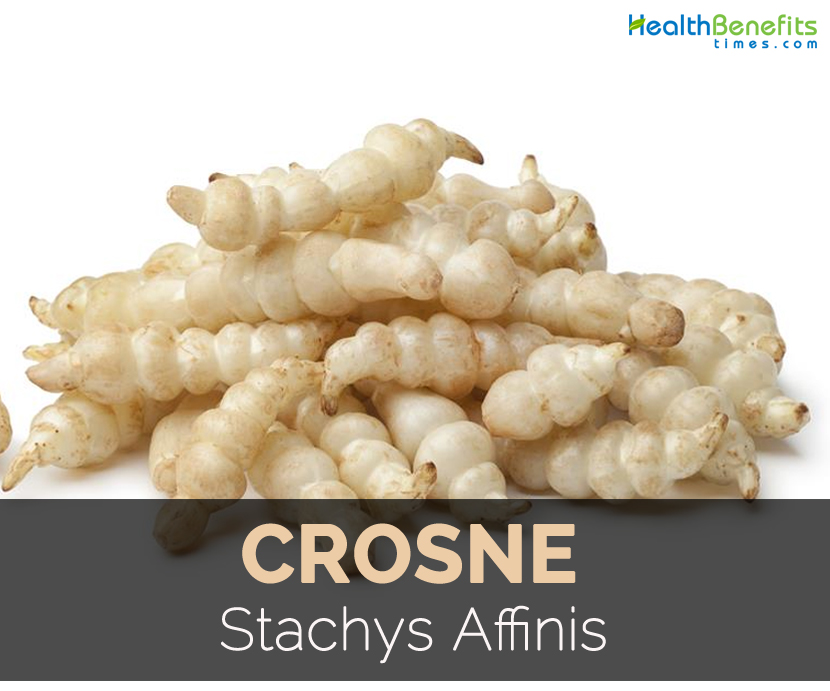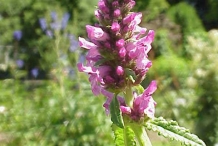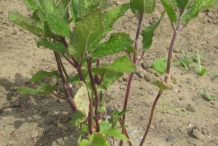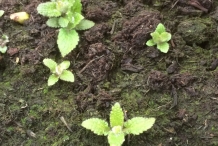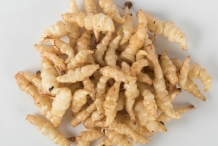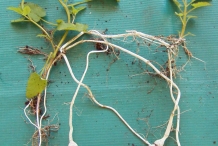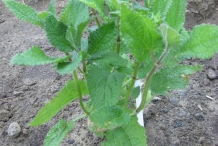| Crosne Quick Facts |
| Name: |
Crosne |
| Scientific Name: |
Stachys Affinis |
| Origin |
It is inherent to China – Gansu, Hubei, Hebei, Nei Monggol, Ningxia, Shaanxi, Qinghai, Shanxi, Shandong, Sichuan and Xinjiang. |
| Colors |
Black-brown |
| Health benefits |
Lower inflammation, Reduce headache, Prevent heart burn, Regulates bowel movement, Prevent heart problems |
Stachys Affinis is a perennial, erect or inclined and deciduous herb which grows to the height of 30 to 120 cm. It has soft and quadrangular stems with base furnished having short rhizomes. Rhizomes are white, fleshy and fusiform worm like tubers measuring 3 to 5 cm long and 1 to 1.2 cm wide which has constricted slightly at nodes that resembles witchetty grub. Leaves are green, opposite which varies in shape as well as size. Leaves are ovate-cordate to ovate oblong about 2.5 to 9.5 cm by 1.5 to 3.5 cm wide. Petioles of leaves are 1 to 2 cm long at middle of the stem that gradually becomes shorter towards stem apex. Flowers are rose purple and are 10 to 15 cm long. Calyx is acute, ovate, turbinate, five toothed (teeth subequal) and measures 6 to 7 mm long. It has 12 to 13 mm long corolla with 9 mm long tube. There are four ascending stamens and ovoid anthers. It has four obovoid, tuberculate, dark brown and 1.5 mm across. The skin is thin ranging from pale beige to ivory to white color. The flesh is white and tender.
Health Benefits of Crosne
The health benefits related to Crosne are discussed below:
- Lower inflammation
It is used for healing ailments. Inflammation is related with managing health problems. It is able to manage inflammatory problems due to active compounds which provide anti-inflammatory properties.
- Reduce headache
Crosne is used for lowering headaches. It is used to aid neuralgia which is used as nerve pain which affects face or head. It is used to lower pain as painkillers which could cause nasty side effects.
- Prevent heart burn
Crosne is an aid for heartburn which is experienced by those mostly suffering from hyperacidity. People with gastroesphageal reflux disease or acid reflux are common with heartburn.
- Regulates bowel movement
It is a great source of fiber. When included on daily diet, it keeps constipation at bay. Consume it with other fiber rich foods and plenty of water for best results.
- Prevent heart problems
Crosne is rich in fiber when consumed regularly. Fiber assists in reducing bad cholesterol which maintains normal blood pressure. Healthy lifestyle and exercise also helps to lower the chances of heart problems.
- Lowers weight
It is helpful for people who are trying to lower weight when added to the regular dies. It is low in fat and high in fiber which is effective to counteract obesity. Due to the richness in fiber, it also prevents overeating and cravings.
Traditional uses
- In China, the plant is used for treating colds and pneumonia.
- The dried or powdered root is used as an anodyne.
Precautions
- Allergic people should avoid it.
- Avoid its excessive use.
How to Eat
- The rhizomes are consumed as root vegetable.
- It is used in salad and vegetable.
- It is pickled in Japanese and Chinese and Japanese cuisine.
- Tubers could be consumed raw or also added to salads, soups, casseroles, stir-fries, sour and sweet, curries and seafoods.
- Tubers could be fried in batter as tempura.
- It could be combined with mushrooms, eggs, noodles and tofu.
- Steam it with other vegetables such as peas, carrots, onions and zucchini.
- Steam it and toss with butter as well as herbs such as parsley, chervil, chives, savory and coriander.
References:
https://www.itis.gov/servlet/SingleRpt/SingleRpt?search_topic=TSN&search_value=833974#null
https://en.wikipedia.org/wiki/Stachys_affinis
Comments
comments


